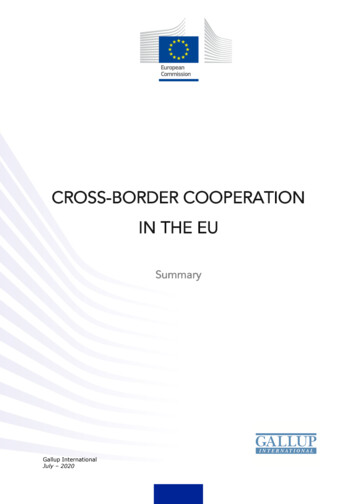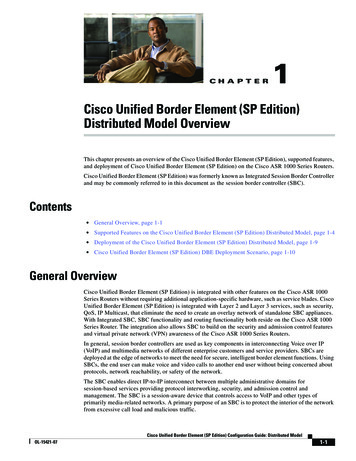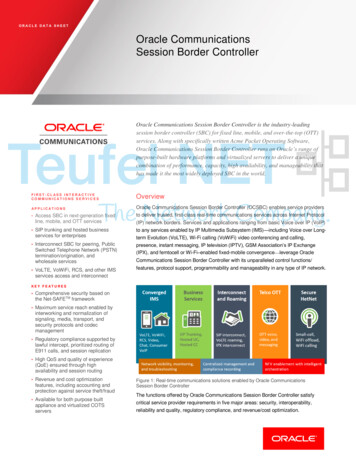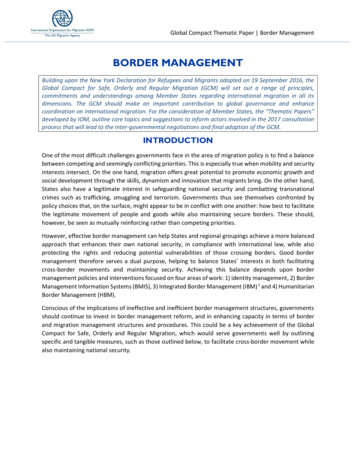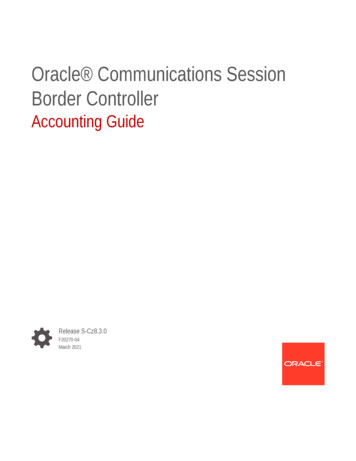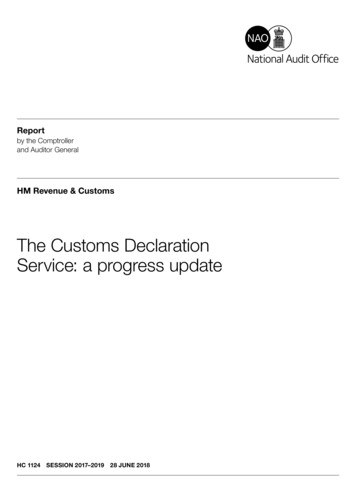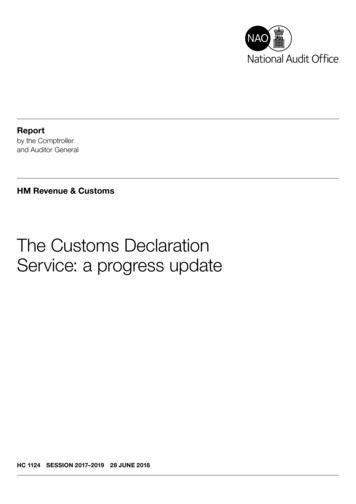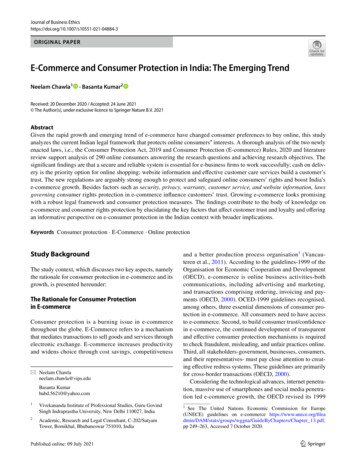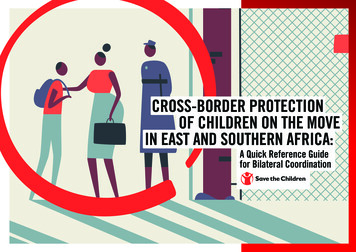
Transcription
CROSS-BORDER PROTECTIONOF CHILDREN ON THE MOVEIN EAST AND SOUTHERN AFRICA:A Quick Reference Guidefor Bilateral Coordination
OUR VISIONA world in which every child attains the right tosurvival, protection, development and participation.OUR MISSIONInspire breakthroughs in the way the world treatschildren and achieve immediate and lasting change intheir lives.OUR VALUESWe will stay true to our values of Accountability,Ambition, Collaboration, Creativity and IntegrityDeveloped by:Sara Lim Bertrand and Kristen M. Castrataro,Proteknôn Consulting Group, LLC with support fromDr Gregor Schnuer and Melinda van Zyl, Save theChildrenPublished by:Save the Children Sweden and Save the ChildrenInternational, East and Southern Africa Regional OfficeFirst Published: 20192
Table of ContentsAcknowledgements.4Acronyms and Abbreviations.51. Introduction.61.1 About this guide.6Aim.6Theory of change.6Terminology.61.2 Children on the Move and the Global Compacts forMigration and on Refugees.71.3 Guiding principles concerning children on the move.82. Rationale for cross-border coordination.92.1 Challenges facing children in situations of migration and displacement.9Different incompatible legislation.9Complexity of stakeholders and their coordination.9Gaps in national protection systems.10Fragmented case management and family tracing and reunification processes.10Negative attitudes towards children in situations of migration or displacement.102.2 The benefits of cross-border coordination.11Possibilities of cross-border coordination.11How cross-border coordination mechanisms support children’s protection.123. Key considerations for implementing a cross-border coordination mechanism.163.1 Establishing a cross-border coordination meeting: Step-by-step.171) Know the context.172) Engage the government.173) Establish a reference group/steering committee.174) Develop terms of reference.185) Secure bilateral commitment.186) Conduct the initial meeting.187) Run regular cross-border meetings.183.2 The roles of stakeholders – Who does what?.193.3 Overcoming key challenges.20Lack of clarity in the purpose.20Attitudes.20Finances.20Cross-cutting issues.21Government sustainability.21Staff changes.22Expansion.224. Conclusion.255. Resources.26Children on the Move.26Gender.263
ACKNOWLEDGEMENTSDedicated commitment from various donors over thelast decade has made it possible to advocate for andsecure the interest and participation of many differentactors to bilateral activities which initially seemedidealistic and impossible at times. In this regard, wewould like to acknowledge the Oak Foundation, theSwedish International Development CooperationAgency (Sida) and the European Union for support inthe historic period covered by the learning presentedin this guide and to extend a special thank you to Sidawho funded this publication and who continues toprovide long-term support to expanding the approach.4
ACRONYMS AND can Charter on the Rights and Welfare of the ChildAfrican UnionBest Interest DeterminationChildren on the MoveCivil Society OrganisationChild and Youth Care CentreEuropean UnionFamily Tracing and ReunificationInternational Organization for MigrationMonitoring, Evaluation, Accountability and LearningMigration Dialogue for Southern AfricaMemorandum of UnderstandingNon-Governmental OrganisationRegional Programming UnitSouthern African Development CommunitySave the ChildrenSave the Children InternationalStandard Operating ProcedureTerms of ReferenceUnaccompanied or Separated Migrant ChildrenUnited NationsUnited Nations Charter for the Rights of ChildrenUnited Nations High Commissioner for RefugeesUnited Nations Children’s Fund5
1. IntroductionCross-border coordination is an effective strategyfor improving the care and protection of children onthe move. For the past decade, state and non-stateactors in Southern Africa have deliberately builtbilateral cross-border mechanisms for coordinatingthe protection of children in situations of migrationor displacement. These mechanisms function acrossborders, between neighbouring governments and alongkey migration routes and borders in Southern Africa.The results include: Improved communication betweencross-border stakeholders at all levels,such as policymakers, social workersand border officials; Harmonised standard operatingprocedures between countries; and Continuous protection for childrenwho are without care.6INTRODUCTION1.1 ABOUT THIS GUIDEAIMThis Quick Reference Guide is a practical guide for allstakeholders who hope to implement a governmentled, cross-border coordination mechanism for theprotection of children who are unaccompaniedand separated while in situations of migrationor displacement. It highlights why cross-bordercoordination mechanisms are important and howthey can be developed. The Quick Reference Guide isdesigned for adaptation or replication in East andSouthern Africa, and possibly other contexts, bydelivering accessible and clear guidance on the whyand the how.THEORY OF CHANGEThe Quick Reference Guide’s theory of change centreson government’s duty of care as primary dutybearer to ensure the protection of children withoutappropriate care, in accordance with internationaland national legislation. In East and Southern Africa,Save the Children has played a key role in supportinggovernments to establish bilateral coordinationmechanisms by leveraging strategic partnerships andproviding technical, logistical and financial supportthroughout the change process. Sustainable, meaningfulchange relies on the commitment and participation ofcountries of origin and transit, as well as host countries,to bring their respective governments together towork jointly for the protection of children on themove.TERMINOLOGYSave the Children defines children on the move as:“Children moving for a variety of reasons,voluntarily or involuntarily, within orbetween countries, with or withouttheir parents or other primarycaregivers, and whose movement,while it may open up opportunities,might also place them at risk (or at anincreased risk) of economic or sexual exploitation, abuse,neglect and violence”.This includes, among other categories: ‘Unaccompanied children’ who are persons underthe age of 18 who are without the care of thosewho are responsible to do so by law or custom; and ‘Separated children’ who are living/moving with theirrelatives but not with their parents or their previouslegal or customary primary caregivers.
1.2 CHILDREN ON THE MOVE ANDTHE GLOBAL COMPACTS FORMIGRATION AND ON REFUGEESThe Global Compact for Migration1, as well as theGlobal Compact on Refugees2, both finalized bythe United Nations in 2018, together represent anunprecedented global commitment to collaborateacross international borders in finding solutions tochallenges posed by migration and displacement, whileremaining responsive to the opportunities for survival,protection and education that are sometimes onlyaccessible through mobility. Both Compacts call fortrans-national cooperation in various ways.In addition, the Global Compact for Migration seeks topromote commitment between state actors chargedwith migration governance to collaborate bi-laterallyin order to improve respect for human rights of peopleseeking to cross international borders (Objective 11).This Guide aligns with the ambitions captured in bothCompacts to leverage bi-lateral collaboration andcommitment for the protection of children on themove. As such, it represents one example of how theseambitions can be translated into pragmatic actionacross borders.The Global Compact on Refugees recommends crossborder cooperation as a strategy to meet the needs ofchildren, adolescents and young people, by facilitatingthe provision of a continuum of care, protection andservices for at-risk children on the move (B, 2.5).The Global Compact for Migration calls forestablishment of cross-border cooperation frameworksto protect migrant children along migratory routes(Objective 7). It also advocates for cross-bordercooperation as a key information exchange andlaw enforcement strategy to strengthen the transnational response to smuggling of migrants, includingvulnerable populations such as children (Objective fugees.htmlINTRODUCTION7
1.3 GUIDING PRINCIPLESCONCERNING CHILDRENON THE MOVEIn 2016, nine principles on the rights of children onthe move were developed as part of an extensiveconsultative process led by the Terre des Hommescampaign ‘Destination Unknown’. This process involvednon-governmental organisations (NGOs), academics,donor agencies and civil society organisations (CSOs).It additionally drew on recommendations set out bythe Committee on the Rights of the Child’s 2012 Dayof General Discussion Report on “The Rights of AllChildren in the Context of International Migration”.Those principles inform the cross-border coordinationapproach detailed in this guide. Save the Children,amongst others, participated in drafting and/oradvocacy work around the principles.3The original tool Recommended principles to guide actions concerning children onthe move and other children affected by migration can be downloaded here: recommended-principle-EN.pdf.More information on the document can be accessed here: https://principlesforcom.jimdo.com.4The term ‘children on the move’ refers to children moving for a variety ofreasons, voluntarily or involuntarily, within or between countries, with orwithout their parents or other primary caregivers. ‘Other children affectedby migration’ refers to children remaining in the country of origin aftertheir parents have migrated and to children living with their parents in thedestination country.38INTRODUCTIONRecommended principles to guide actions concerning childrenon the move and other children affected by migration4A child firstChildren on the move and other children affected by migration shall be consideredchildren, first and foremost, and their best interests shall be a primary consideration in allactions concerning them.Life, survival anddevelopmentAll children have the right to life, survival and development.Freedom of movementChildren have the rights (a) to liberty of movement within their State and (b) to leave theirState and any other.No child detentionThe detention of children because of their or their parents’ migration status constitutes achild rights violation and always opposes the principle of the best interests of the child.Families belongtogetherChildren in all phases of migration shall not be separated from their parents or primarycaregivers (unless this is in their best interests).No child is illegalNo child is illegal: children should be protected against all forms of discrimination.Inclusive childprotection systemsChild protection systems shall protect all children, including children on the move andchildren affected by migration.Human rights inmigrationMigration management measures shall not adversely affect children’s human rights.Child participationChildren have the right to express their views freely in all matters affecting them andto have their views taken into consideration in accordance with their age, maturity andunderstanding of the options available.
2. Rationale for cross-border coordination2.1 CHALLENGES FACINGCHILDREN IN SITUATIONS OFMIGRATION AND DISPLACEMENTChildren in situations of migration or displacementcan be particularly vulnerable to protection risks.They have the same rights as all children, yet theirdouble status as “unaccompanied or separatedchildren” and “migrants” can expose them toadditional violations or non-fulfilment of those rights.Cross-border migration and displacement involve avariety of multinational systems and stakeholders thatcan present risks for children.DIFFERENT OR INCOMPATIBLELEGISLATIONChildren in situations of migrationor displacement can be affected bymany different types of legislationthat governs movement andmigration. Children’s migrant status may limit their ability tomeet certain requirements for services, such as theneed for documentation. Migration legislation may lack special provisions forchildren and be inconsistent with child protectionlegislation.COMPLEXITY OF STAKEHOLDERS ANDTHEIR COORDINATIONThe protection of children in situations of migrationor displacement involves a widerrange of stakeholders (such asgovernment officials, NGOs, CSOsand others on both sides of theborder) than the protectionof national children. Thestakeholders in both countries maybe unaware of: Their counterparts in the neighbouring country; Stakeholders with different mandates within theirown country; Gaps and inconsistencies in policies within andbetween countries; National and cross-border referral pathways; and Procedural requirements for reunification (suchas case files or other documentation) that arenecessary for children’s protection.Good Practice:Cooperation ondocumentationThrough bilateralcommunication, Mozambique becameaware of the impact the lack ofdocumentation had on Mozambicanchildren’s ability to access servicesin South Africa. Consular servicesin destination areas responded byoffering to interview and documentidentified Mozambican children on themove, especially in border communities.RATIONALE FOR CROSS-BORDER COORDINATION9
“Cross-border cooperationis required to createa continuum of carewith harmonised casemanagement systems,referral systems andstandard operatingprocedures.”GAPS IN NATIONALPROTECTION SYSTEMSMost countries submit to the sameinternational legislation governing theprotection of children, including childrenon the move. However, national legislation,policies and procedures vary between countries. Whenchild protection systems are not harmonised acrossinternational borders, children may experience: Gaps in care and protection during transit as well asin the way they are received upon arrival; Inconsistent case management; Custodial changes from social services toimmigration; or Family tracing processes without best interestdeterminations.FRAGMENTED CASE MANAGEMENT ANDFAMILY TRACING AND REUNIFICATIONPROCESSESChildren who are unaccompanied or separatedwhile in situations of migration or displacement areoften involved in a family tracing and reunificationprocess. Whether started by the parents or thechild’s temporary caregivers, the process can takeyears. Without appropriate and coordinated casemanagement and family tracing processes, children canface increased risks of:10RATIONALE FOR CROSS-BORDER COORDINATION Inadequate or harmful interim care; Untreated physical conditions; Untreated emotional conditions; and Permanent family separation.NEGATIVE ATTITUDES TOWARDS CHILDRENIN SITUATIONS OF MIGRATION ORDISPLACEMENTIrregular migrants are at higher risk of beingstigmatised and ostracised in hostcommunities. This can be especially trueof children without adequate parentalcare, they have more vulnerabilitiesand fewer easily recognisable assetsthat communities value. Negativeattitudes can expose children to: Discrimination; Abuse; Police harassment; and Legal or social barriers to services.
2.2 THE BENEFITS OF CROSSBORDER COORDINATIONCoordination across child protection systemsand migration governance can result in:POSSIBILITIES OF CROSS-BORDERCOORDINATIONChildren who are unaccompanied or separatedwhile in situations of migration or displacement canexperience specific protection risks that arise from acombination of (a) the challenges above and (b) a gapin one (or more) of three key areas – coordination,communication or access. Frontline border officials being aware of childprotection policies; and Social workers understanding processes fordetermining children’s best interests andsupporting family tracing and reunification.Cross-border coordination can address thesechallenges by improving coordination andcommunication between national and internationalstakeholders and ensuring consistent access to care,protection and services for children on the move. Teachers and school principals who haveguidance on how to enrol children who are inmigration.Communication between stakeholders canresult in:Access to care, protection and other basicservices such as health, education anddocumentation can result in: Children having to access the documentationrequired for essential services; and Children in situations of migration ordisplacement being included in the nationalprotection systems instead of relying on “specialprovisions” alone that may have large capacitygaps and make individual children’s protectiondependent on the specific official encountered.“Cross-bordercoordination canstrengthen coordinationand communicationbetween stakeholdersand ensure consistentaccess to care,protection and servicesfor children on themove.”RATIONALE FOR CROSS-BORDER COORDINATION11
Good Practice:Needs-basedgroups/meetingsThe proliferation ofsub-groups and meetings is a sideeffect of bilateral meetings. Theseoffshoots often address specificcommunication and exchange needs.HOW CROSS-BORDER COORDINATIONMECHANISMS SUPPORT CHILDREN’SPROTECTIONCross-border coordination mechanisms supportthe protection of unaccompanied and separatedchildren in situations of migration or displacementby strengthening the three areas ofcoordination, communication and access.1Coordinate child protectionservices and systems acrossborders.Cross-border coordination mechanisms seek to:EXAMPLE: A border postreference group in Zambia thatincludes immigration, police, localCSOs and social workers meetsregularly to discuss issues relevantto the specific border where thesefrontline officials are working.12RATIONALE FOR CROSS-BORDER COORDINATION Improve communication between frontline borderofficials; Harmonise/align standard operating procedures andcorresponding action plans; and Implement a seamless, cross-border child protectionsystem that supports comprehensive, rights-basedservices at all stages of case management, includingfamily tracing and reunification.
2Improve horizontal (acrossdifferent departments andstakeholders) and vertical(from local to national level)communication.All stakeholders: Share relevant information; Understand legally guaranteed protection services; Recognise unaccompanied and separated children onthe move as distinct rights-holders with unique risksand vulnerabilities; and Affirm their specific commitments regardingmandates, budgets, legal clarifications, etc.Cross-border coordination mechanisms can be initiatedby local-level actors, but lasting improvements inbilateral coordination and communication require thesupport of national leaders and policy makers. Accessto services is partly a matter of available resources,but it is also a matter of political priorities andinternational good will.Good Practice:Harmonised SOPsThe StandardOperating Procedures(SOPs) between South Africa andZimbabwe outline clear guidelinesfor family tracing, family assessment,best interest determination (includingchild participation), alternativecare placement, follow-up and caseclosure. The SOPs emphasise careto-care repatriation, internationalcommunication and consistent casemanagement (including documentation).RATIONALE FOR CROSS-BORDER COORDINATION13
3Ensure that a child’s legal status does not directlyor indirectly restrict their access to key services,including best interests determinations, casemanagement, education, shelter, food, health anddocumentation. Ongoing monitoring allows the coordinationmechanism to understand whether these objectivesare being met. Directly refers to policies or laws that only apply tonational children. Indirectly refers to legislation or policy that grantsuniversal access but includes requirements thatchildren in migration are unable or less likely to reach.“Cross-border coordination mechanisms seek to implement a seamless,cross-border child protection system that supports comprehensive,rights-based services at all stages of case management, includingfamily tracing and reunification.”14RATIONALE FOR CROSS-BORDER COORDINATION
Challenges facing childrenon the moveInterventionsIndicator guidanceRelevance to Global CompactsMultiple, contradictoryor incompatible types oflegislationHarmonise policies and specific provisionsthat target the needs of children insituations of migration or displacementNational laws and policies are harmonisedacross borders to provide care and protectionto children without appropriate care insituations of migration or displacement [Yes]GCM: Cross-border cooperation frameworks (Objective 7)GCR: Cross-border cooperation for child protection (B, 2.5)Complex range ofstakeholdersCommunicate and coordinate betweencross-border stakeholdersRecurrent opportunities are institutionalisedfor regular, ongoing coordination betweencross-border stakeholders (e.g. Cross-bordercoordination meetings or other platforms forinteraction that occur on a regular, predictablebasis) [Yes]Gaps between/across nationalprotection systemsMap and identify protection gaps inprotection systems and develop jointaction plans to address gaps (e.g.inadequate access to basic services or casemanagement for children on the move)Migrant-sensitive national protection systemsand monitored action plans support the careand protection of children without adequatecare in situations of migration or displacement[Yes]GCM: Include migrant children in national CP systems byestablishing robust procedures for the protection of migrantchildren as well as cross border cooperation frameworksGCR: Cross-border cooperation for child protection (B, 2.5)Fragmented casemanagement and familytracing and reunificationprocessesHarmonise case management proceduresand information-sharing protocols betweencountriesCross-border standard operating proceduresand action plans are in use and reviewed on anongoing basis [Yes]GCM: “cross-border cooperation frameworks, in order to ensurethe best interests of the child are appropriately integrated”GCR: Best interest assessment and/or determination (B 1.5);Support family tracing (B, 2.5)Negative attitudes towardschildren in situations ofmigration or displacementSensitise stakeholders by sharing storiesfrom and about actual children in situationsof migration or displacement that arerespectful and based on shared valuesRegular sensitisation for relevant duty bearers[Yes]GCM: Intra- and cross-regional, trauma-informed trainings forfirst responders and government officialsTraining in rights of the child and child sensitive proceduresGCR: Invest in national CP systems and training authorities inchild sensitive procedures (B, 2.5) and cross border protectionRATIONALE FOR CROSS-BORDER COORDINATION15
3. Key considerations for implementinga cross-border coordination mechanismKNOW THECONTEXTENGAGE THEGOVERNMENT1ESTABLISH AREFERENCE GROUP/STEERING COMMITTEE2DEVELOP TERMSOF REFERENCE347RUN REGULARCROSS-BORDERMEETINGS16KEY CONSIDERATIONS6CONDUCTTHE INITIALMEETING5SECURE BILATERALCOMMITMENT
3.1 ESTABLISHING A CROSS-BORDERCOORDINATION MEETING: STEP-BY-STEP1) KNOW THE CONTEXTCollaborate with governments and other stakeholders to: Map governmental and non-governmental stakeholders in host countriesand/or countries of origin (including their perceptions of children inmigration). Review participating countries’ legislation, policies and procedures(including gaps or discrimination) that influence the protection ofchildren in migration. Identify non-threatening or urgent entry pointsfor harmonising policies or procedures that can be used to engagegovernments bilaterally. Map basic services and their accessibility to children who areunaccompanied, separated, in migration or displaced.2) ENGAGE THEGOVERNMENTOnce there is an evidence base, build on Save the Children’s relationshipswith governments to gauge: Governments’ interest in protecting children in migration; and The possibility of bilaterally engaging neighbouring countries.3) ESTABLISH A REFERENCEGROUP/STEERINGCOMMITTEESupport the establishment of a national-level reference group or steeringcommittee that: Includes key governmental and non-governmental stakeholders; Establishes a national-level purpose for the bilateral meetings; Ensures the attendance of key stakeholders; Aligns cross-border meetings to overall government policies andinterests; and Supports cross-border meeting logistics by reviewing minutes, assessingprogress towards agreed-upon actions and organising the meetings.KEY CONSIDERATIONS17
The referencegroup and/or steeringcommittee: Sets the agenda that invitedparticipants agree upon. Confirms the date set at aprevious meeting. Reviews participants. Issues invitation letters andagenda. Works with Save the Childrento organise transport,conferencing and, if required,translators. Confirms chair and scribe. Works with Save the Childrento determine who takesminutes, records agreedupon actions and arrangessubsequent meeting dates. Finalises and circulates minutes. Implements action list.18KEY CONSIDERATIONS4) DEVELOP TERMS OFREFERENCEDevelop and clarify national-level terms of reference that: Capture the purpose of the meetings; Connect the protection of children on the move to wider childprotection and migration agendas; and Support the development of joint action plans that govern the bilateralinteraction and cooperation during meetings.5) SECURE BILATERALCOMMITMENTIn order to secure interest and commitment from both countries: Save the Children Country Offices from both countries mustcommunicate their progress to each other; Save the Children Country Offices must communicate with respectivegovernments; and Governments must engage with each other to coordinate the initialmeetings.6) CONDUCT THEINITIAL MEETINGInitial meetings may feel hostile or uncomfortable, but over time attitudestend to shift towards more collegial interaction and focus more clearly oncross-border child protection. The exact content and agenda of the firstcross-border coordination meeting will depend on: Political mood; National perceptions of purpose (often different between sending, transitand receiving countries); Progress on Terms of Reference; and The extent of bilateral engagements in other spheres.7) RUN REGULAR CROSSBORDER MEETINGSOnce governments have agr
law enforcement strategy to strengthen the trans-national response to smuggling of migrants, including vulnerable populations such as children (Objective 9). In addition, the Global Compact for Migration seeks to promote commitment between state actors charged with migration governance to collaborate bi-laterally
